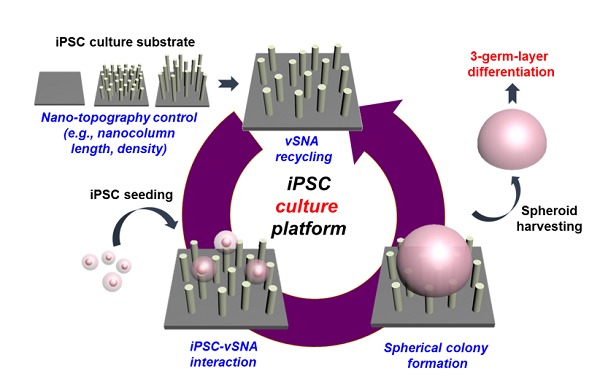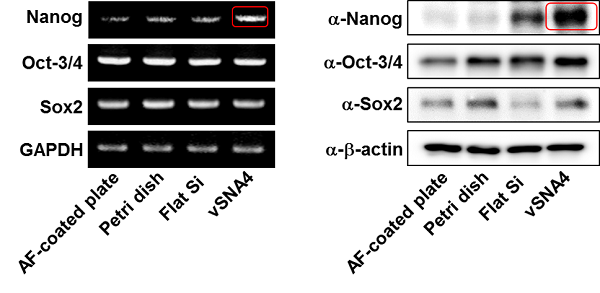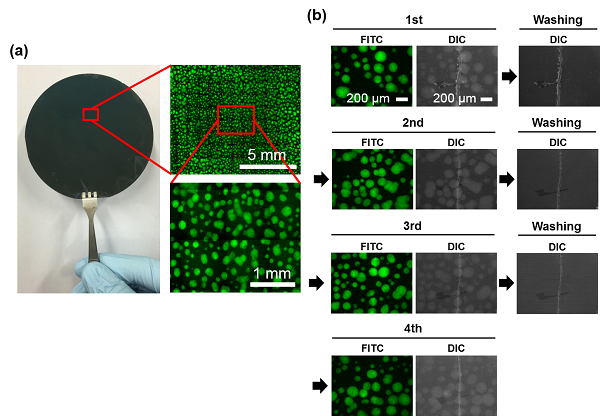Media Center
A multimedia mosaic of moments at GIST
GIST Excellence
[Press release] Professor Myung-Han Yoon leads a research team to create pluripotent stem cell colonies using vertical nanocolumns
- 엘리스 리
- REG_DATE : 2016.10.28
- HIT : 846
Professor Myung-Han Yoon leads a research team
to create pluripotent stem cell colonies using vertical nanocolumns

Representative fluorescence images of colonies stained with CFDA. Scale bars denote 200 μm.
The biological applications of vertical nanostructures mostly rely on their intracellular accessibility through the cellular membrane by promoting cell-to-nanostructure interactions. Professor Myung-Han Yoon of the School of Materials Science and Engineering at the Gwangju Institute of Science and Technology (GIST) has led a research team to develop a seemingly counter-intuitive approach for the spontaneous formation of mouse induced pluripotent stem cell (iPSC)-derived three-dimensional spherical colonies with unlimited self-renewal and differentiation potential.

The overall schematic of preparing iPSC-derived spherical colonies
using the geometry-controlled vSNAs with flat-top nanocolumns.
The comprehensive analyses of iPSCs cultured on vertical silicon nanocolumn arrays (vSNAs) with various nanocolumn geometries show reduced cell-to-substrate adhesion and enhanced cell-tocell interactions under optimized vSNA conditions, successfully accommodating the spontaneous production of iPSC-derived spherical colonies. Remarkably, these colonies which were only minimally penetrated by and thereby easily harvested from wafer-sized vSNAs display a substantial increase in pluripotency marker expression and successfully differentiate into three germ layers. vSNAs that are capable of large-scale fabrication, which are efficient for spherical colony formation, and reusable for multiple iPSC culture could serve as a broad-impact culture platform for stem cell research.

(Left) Immunoblot analysis of the following pluripotent stem cell markers: Nanog, Oct-3/4, and Sox2; β-actin was used as a control. (Right) Semiquantitative RT-PCR analysis of naïve stem cell markers Rex-1 and Stella. GAPDH was used as a control.
Their paper entitled "Vertical nanocolumn-assisted pluripotent stem cell colony formation with minimal cell-penetration" and authored by Hyunju Kim, Dong Hee Kang, Kyung Hee Koo, Seyeong Lee, Seong-Min Kim, Janghwan Kim, Myung-Han Yoon, So Yeon Kim, and Eun Gyeong Yang was published on September 16, 2016, by Nanoscale.

Feasibility of vSNAs as a large-scale reusable platform for stem cell culture. (a) The optical photography of a large-size vSNA4 substrate (3-inch Si wafer, left), stitched (upper right) and representative (lower right) fluorescence microscopy images of iPSCs on a large-size vSNA4 substrate after 3 days of culture. Scale bars denote 5 mm (upper right) and 1 mm (lower right). (b) Reuse of vSNAs for iPSC culture. Scratches on vSNA4 were deliberately generated before cell culture, and then the spherical colonies were fluorescently imaged after 3 days of culture. After being washed to remove the colonies, the vSNA4 was repeatedly reused for stem cell culture. Both fluorescence and DIC microscopy images of spherical iPSC-derived colonies were captured. All scale bars denote 200 μm.
Professor Myung-Han Moon said, "In recent years, induced pluripotent stem cells are an ethical alternative to embryonic stem cells and is of great interest to researchers in regenerative medicine. Our research has developed a vertical nanocolumn method to culture induced pluripotent stem cells, and this has the potential to affect numerous areas of research."